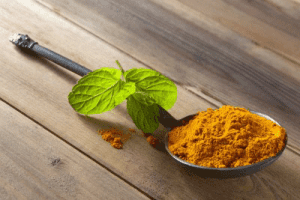By Sayer Ji
Contributing Writer for Wake Up World
Since ancient times, turmeric has been used for remedying oral ailments, among other therapeutic applications too numerous to count.[1] Consider that plants like turmeric were first eaten for thousands of years before our species ever devised the modern day oddity of encapsulated or tableted extracts that could be swallowed without significant oral contact. It is only logical, therefore, that after long stretches of biological time, taking the root orally as either food, spice or medicine, it would agree with and have benefit for that part of our anatomy and its unique physiology.
Indeed, recent research shows that turmeric extract and turmeric oil may even reverse precancerous changes in oral submucous fibrosis in humans.[2] [3] In addition, there are at least a dozen studies showing turmeric extract can kill oral cancer cells,[4] including a recent study showing that turmeric extract-loaded nanoparticles kill chemotherapy-resistant oral cancer cells.[5] But turmeric’s positive role to play in oral health encompasses more than relatively rare health issues like oral cancer, as it also has tangible value to the vast majority of folks who use common mouthwash in an attempt to keep their mouth clean of plaque.
Turmeric contains approximately 3-4% curcumin by dry weight. This yellow pigmented polyphenol has been studied extensively in human clinical research as a natural alternative to the common mouthwash ingredient known as chlorhexidine for the treatment of gingivitis, “inflammation of the gum tissue.”
Gingivitis is classified as a non-destructive periodontal disease,[6] and involves bacterial plaque-induced inflammation, but if left untreated, it can progress to a form of periodontal disease that can be highly destructive. Some of the most common symptoms associated with gingivitis are bad breath (halitosis), and bleeding, bright, tender or swollen gums.
Chlorexidine, while considered the gold standard in dentistry for the prevention of dental plaque,[7]was flagged in 2012 in a patient safety alert issued by the UK’s Medicines and Healthcare Products Regulatory Agency (MHRA), due to its potential to induce anaphylactic reactions.[8] While chlorexidine-induced analaphylaxis is an exceedingly rare reaction, low level exposure has been confirmed in numerous scientific studies to cause a variety of complications.[9] [10] [11] Clearly, safer alternatives are needed and especially if they can be shown to be more effective.
Turmeric Mouthwash Shown Superior to Chlorexidine
In 2012, a study published in the Journal of Indian Society of Periodontology compared the efficacy of a .1% curcumin extract mouthwash + .01% eugenol (Group A) to a more strongly concentrated .2% chlorhexidine gluconate mouthwash (Group B), in subjects with mild to moderate gingivitis. Both Group A and Group B consisted of 30 subjects who were advised to use 10 ml of mouthwash with equal dilution of water for 1 min twice a day 30 min after brushing. They were then tracked for plaque and gingival changes at day 0, day 14 and day 21. Both their direct experience (subjective) and objective criteria were assessed at days 14 and 21.
The results were as follows:
On comparison between chlorhexidine and turmeric mouthwash, percentage reduction of the Plaque Index between 0 and 21 st day were 64.207 and 69.072, respectively (P=0.112), percentage reduction of Gingival Index between 0 and 21st day were 61.150 and 62.545 respectively (P=0.595) and percentage reduction of BAPNA [The N-benzoyl-l-arginine-p- nitroanilide assay; a measurement of pathogenic bacterial activity] values between 0 and 21st day were 42.256 and 48.901 respectively (P=0.142). [emphasis added]
In all three objective parameters tested, turmeric extract was at least as effective as chlorhexidine mouthwash at improving the patient’s oral health. However, technically, the curcumin formulation beat out the chemical mouthwash in all 3 measurements, and at only one-half the concentration.
Also, subjective evaluations showed that the turmeric mouthwash was better received by the subjects.
In the characteristically conservative style of academia, the author’s concluded:
Chlorhexidine gluconate as well as turmeric mouthwash can be effectively used as an adjunct to mechanical plaque control in prevention of plaque and gingivitis. Both the mouthwashes have comparable anti-plaque, anti-inflammatory and anti-microbial properties.
Additional human clinical research has confirmed curcumin’s effectiveness as a chlorexidine alternative in reducing plaque,[12] as well as reducing plaque-associated gum inflammation.[13]
One of the major differences with a turmeric (curcumin)-based mouthwash is that if one happened to swallow some, it would not result in the type of adverse effects associated with a biocidal/antiseptic chemical such as chlorhexidine. In fact, given the broad range of documented health benefits of turmeric, it would actually provide some side benefit, were this to happen.
Ultimately, the choice is yours. But remember, always exert caution when embarking on any new dietary and/or supplement change, and do so under the guidance of a trained professional such as a medical herbalist or integrative physician. And remember, the quality of the herb will depend on whether it was organically produced (non-irradiated), well-handled and preserved in order to eliminate mycotoxins and related microbial contaminants.
Updated September 20414
Article References
[1] Note: Our research project on turmeric alone has identified over 600 experimentally confirmed health benefits of turmeric and/or curcumin.
[2] Jayashree Joshi, Sadhana Ghaisas, Ashok Vaidya, Rama Vaidya, D V Kamat, A N Bhagwat, Sumati Bhide. Early human safety study of turmeric oil (Curcuma longa oil) administered orally in healthy volunteers. J Assoc Physicians India. 2003 Nov ;51:1055-60. PMID: 15260388
[3] Balwant Rai, Jasdeep Kaur, Reinhilde Jacobs, Jaipaul Singh. Possible action mechanism for curcumin in pre-cancerous lesions based on serum and salivary markers of oxidative stress. J Oral Sci. 2010;52(2):251-6. PMID: 20587949
[4] GreenMedInfo.com, Professional Database Feature: Focus Curcumin Articles to Oral Cancer (17 results)
[5] Pei-Ying Chang, Shu-Fen Peng, Chao-Ying Lee, Chi-Cheng Lu, Shih-Chang Tsai, Tzong-Ming Shieh, Tian-Shung Wu, Ming-Gene Tu, Michael Yuanchien Chen, Jai-Sing Yang. Curcumin-loaded nanoparticles induce apoptotic cell death through regulation of the function of MDR1 and reactive oxygen species in cisplatin-resistant CAR human oral cancer cells. Int J Oncol. 2013 Oct ;43(4):1141-50. Epub 2013 Aug 5. PMID: 23917396
[6] The American Academy of Periodontology. Proceedings of the World Workshop in Clinical Periodontics. Chicago:The American Academy of Periodontology; 1989:I/23-I/24.
[7] Amita M Mali, Roobal Behal, Suhit S Gilda. Comparative evaluation of 0.1% turmeric mouthwash with 0.2% chlorhexidine gluconate in prevention of plaque and gingivitis: A clinical and microbiological study. J Indian Soc Periodontol. 2012 Jul ;16(3):386-91. PMID: 23162334
[8] MHRA, Medical Device Alert, Issued Oct. 2012
[9] Sivathasan, Niroshan; Ramamurthy, Nitin Kumar; Pabla, Ravinder Singh (2010). “Chemical Burns Associated with Chlorhexidine-Alcohol Solution: An Avoidable Complication?”. Journal of Burn Care & Research 31 (5): 833. doi:10.1097/BCR.0b013e3181eed4d6. PMID 20644490
[10] Sivathasan, N; Sivathasan, N; Vijayarajan, L (2010). “Chlorhexidine’s complications”. Journal of perioperative practice 20 (8): 300–1. PMID 20860191
[11] Sivathasan, N.; Goodfellow, P. B. (2011). “Skin Cleansers: The Risks of Chlorhexidine”. The Journal of Clinical Pharmacology 51 (5): 785–6.doi:10.1177/0091270010372628. PMID 21383335
[12] Pf Waghmare, Au Chaudhari, Vm Karhadkar, As Jamkhande. Comparative evaluation of turmeric and chlorhexidine gluconate mouthwash in prevention of plaque formation and gingivitis: a clinical and microbiological study. J Contemp Dent Pract. 2011 ;12(4):221-4. Epub 2011 Jul 1. PMID: 22186854
[13] Sangeeta Muglikar, Kalpak Chandrakant Patil, Sumanth Shivswami, Rashmi Hegde. Efficacy of curcumin in the treatment of chronic gingivitis: a pilot study. Oral Health Prev Dent. 2013 ;11(1):81-6. PMID: 23507685
Further articles by Sayer Ji
- New Study Signals Wheat-Autism Link
- Biophotons: The Human Body Emits, Communicates with, and is Made from Light
- 10 Natural Substances That Could Help Cure Type-1 Diabetes
- Glyphosate (Roundup) Carcinogenic In the PARTS PER TRILLION Range
- How to Clean Your Arteries With One Simple Fruit
- 13 Evidence-Based Medicinal Properties of Coconut Oil
About the author:
 Sayer Ji is the founder and director of www.GreenMedInfo.com and an advisory board member at the National Health Federation, an international nonprofit, consumer-education, health-freedom organization.
Sayer Ji is the founder and director of www.GreenMedInfo.com and an advisory board member at the National Health Federation, an international nonprofit, consumer-education, health-freedom organization.
He co-authored the book Cancer Killers: The Cause Is The Cure, and is currently co-authoring another book with Tania Melkonian entitled EATomology: An Edible Philosophy of Food.
Check out Sayer Ji’s new collaborative project EATomology.

If you've found value in our articles, we invite you to support the release of our brand-new book, "Gratitude Practices for Kids: A Practical Guide for Adults to Instill a Spirit of Appreciation and Positivity in the Next Generation."
"Gratitude Practices for Kids" brings together over 25 innovative and accessible practices designed to enhance gratitude in everyday life. This comprehensive guide is backed by 17 scientific studies, ensuring each concept is grounded in research, underscoring our commitment to nurturing growth, emotional intelligence, and positive interactions between adults and children.
We encourage you to opt for the paperback version to celebrate this new release. Dive into its fresh pages away from digital distractions, allowing you to immerse yourself in the transformative practices it offers.
Over recent years, Wake Up World has faced significant online censorship, which has impacted our financial ability to operate. Moving into book publishing represents a strategic step to secure the ongoing funds needed to continue our mission. By purchasing Gratitude for Kids, you help us keep our content free and accessible to everyone, avoiding needing a paywall. With over 8,500 articles published in the last 13 years, we remain dedicated to keeping our valuable content open to all.








